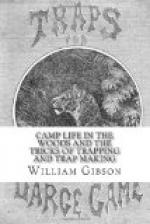[Illustration]
The food of the black bear is mostly of a vegetable character, animal diet not being indulged in unless pressed by hunger. At such times it seems to especially prefer a young pig as the most desirable delicacy; and even full-grown hogs, it is said, are sometimes lifted from their pens and carried off in his deadly embrace.
Honey is his especial delight; and he will climb trees with great agility in order to reach a nest of bees, there being few obstacles which his ready claws and teeth will not remove where that dainty is in view. He is also very fond of acorns, berries, and fruits of all kinds.
The young of the bear are produced in January or February, and are from one to four in number. They are very small and covered with grey hair, which coat they retain until they are one year of age. The flesh of the bear is held in high esteem among hunters, and when properly prepared is greatly esteemed by epicures.
The fat of the animal is much used under the title of “Bear [Page 171] grease,” and is believed to be an infallible hair rejuvenator, and therefore becomes a valuable article of commerce.
The bear generally hibernates during the winter, choosing some comfortable residence which it has prepared in the course of the summer, or perhaps betaking itself to the hollow of some tree. Sometimes, in case of early snow, the track of the bears may be distinguished, and if followed will probably lead to their dens, in which they can be secured with logs until it is desired to kill them.
The black bear has a habit of treading in a beaten track, which is easily detected by the eye of an experienced hunter or trapper, and turned to good account in trapping the animal.
There are various modes of accomplishing this result. The bear Dead-fall, described on page 17, is, perhaps, the most commonly used, and the Pit-fall, page 31, and “Giant Coop” trap are also excellent. The Gun trap and stone dead-fall, page 20, we also confidently recommend. When a steel trap is used it requires the largest size, especially made for the purpose. It should be supplied with a short and very strong chain firmly secured to a very heavy clog or grappling-iron page 147. If secured to a tree or other stationary object, the captured animal is likely to gnaw or tear his foot away, if, indeed, he does not break the trap altogether by the quick tightening of the chain. The clog should be only heavy enough to be an impediment, and may consist of a log or heavy stone. The grappling-iron, however, is more often used in connection with the bear trap. It is a common method in trapping the bear to construct a pen of upright branches, laying the trap at its opening, and covering it with leaves. The bait is then placed at the back in such a position that the animal, on reaching for it, will be sure to put his foot in the trap.




